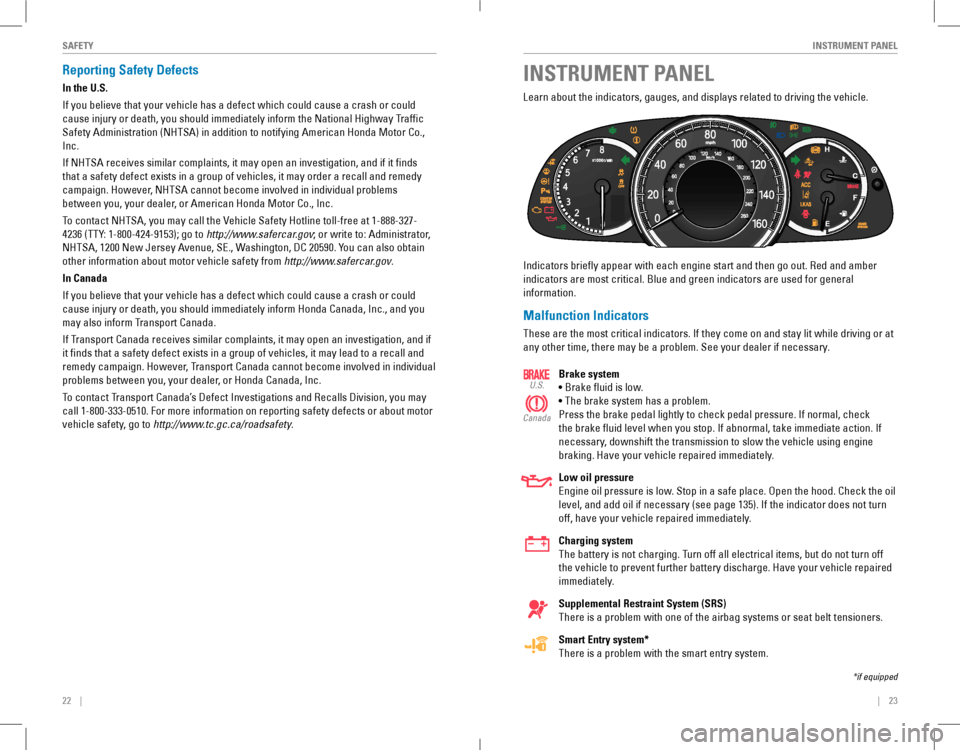check transmission fluid HONDA ACCORD COUPE 2016 9.G Quick Guide
[x] Cancel search | Manufacturer: HONDA, Model Year: 2016, Model line: ACCORD COUPE, Model: HONDA ACCORD COUPE 2016 9.GPages: 84, PDF Size: 19.4 MB
Page 15 of 84

22 || 23
INSTRUMENT PANELSAFETY
INSTRUMENT PANELReporting Safety Defects
In the U.S.
IfŌĆéyouŌĆébelieveŌĆéthatŌĆéyourŌĆévehicleŌĆéhasŌĆéaŌĆédefectŌĆéwhichŌĆécouldŌĆécauseŌĆéaŌĆécrashŌĆéorŌĆécouldŌĆé
cause injury or death, you should immediately inform the National Highway Traffic
Safety Administration (NHTSA) in addition to notifying American Honda \
Motor Co.,
Inc.
IfŌĆéNHTSAŌĆéreceivesŌĆésimilarŌĆécomplaints,ŌĆéitŌĆémayŌĆéopenŌĆéanŌĆéinvestigation,ŌĆéandŌĆé ifŌĆéitŌĆéfindsŌĆé
that a safety defect exists in a group of vehicles, it may order a recal\
l and remedy
campaign.ŌĆéHowever,ŌĆéNHTSAŌĆécannotŌĆébecomeŌĆéinvolvedŌĆéinŌĆéindividualŌĆéproblemsŌĆé
betweenŌĆéyou,ŌĆéyourŌĆédealer,ŌĆéorŌĆéAmericanŌĆéHondaŌĆéMotorŌĆéCo.,ŌĆéInc.
To contact NHTSA, you may call the vehicle Safety Hotline toll-free at 1-888-327-
4236 (TTY: 1-800-424-9153); go to http://www.safercar.gov; or write to: Administrator,
NHTSA,ŌĆé1200ŌĆéNewŌĆéJerseyŌĆéAvenue,ŌĆéSE.,ŌĆéWashington,ŌĆéDCŌĆé20590.ŌĆéYouŌĆécanŌĆéalsoŌĆéobtainŌĆé
otherŌĆéinformationŌĆéaboutŌĆémotorŌĆévehicleŌĆésafetyŌĆéfromŌĆéhttp://www.safercar.gov.
In Canada
IfŌĆéyouŌĆébelieveŌĆéthatŌĆéyourŌĆévehicleŌĆéhasŌĆéaŌĆédefectŌĆéwhichŌĆécouldŌĆécauseŌĆéaŌĆécrashŌĆéorŌĆécouldŌĆé
causeŌĆéinjuryŌĆéorŌĆédeath,ŌĆéyouŌĆéshouldŌĆéimmediatelyŌĆéinformŌĆéHondaŌĆéCanada,ŌĆéInc.,ŌĆéandŌĆéyouŌĆé
may also inform Transport Canada.
IfŌĆéTransportŌĆéCanadaŌĆéreceivesŌĆésimilarŌĆécomplaints,ŌĆéitŌĆémayŌĆéopenŌĆéanŌĆéinvestigation,ŌĆéandŌĆéifŌĆé
it finds that a safety defect exists in a group of vehicles, it may le\
ad to a recall and
remedyŌĆécampaign.ŌĆéHowever,ŌĆéTransportŌĆéCanadaŌĆécannotŌĆébecomeŌĆéinvolvedŌĆéinŌĆéindividualŌĆé
problemsŌĆébetweenŌĆéyou,ŌĆéyourŌĆédealer,ŌĆéorŌĆéHondaŌĆéCanada,ŌĆéInc.
ToŌĆécontactŌĆéTransportŌĆéCanadaŌĆÖsŌĆéDefectŌĆéInvestigationsŌĆéandŌĆéRecallsŌĆéDivision,ŌĆéyouŌĆémayŌĆé
callŌĆé1-800-333-0510.ŌĆéForŌĆémoreŌĆéinformationŌĆéonŌĆéreportingŌĆésafetyŌĆédefectsŌĆéorŌĆé aboutŌĆémotorŌĆé
vehicle safety, go to http://www.tc.gc.ca/roadsafety.
LearnŌĆéaboutŌĆétheŌĆéindicators,ŌĆégauges,ŌĆéandŌĆédisplaysŌĆérelatedŌĆétoŌĆédrivingŌĆétheŌĆévehicle.
IndicatorsŌĆébrieflyŌĆéappearŌĆéwithŌĆéeachŌĆéengineŌĆéstartŌĆéandŌĆéthenŌĆégoŌĆéout.ŌĆéRedŌĆéandŌĆéamberŌĆé
indicators are most critical. Blue and green indicators are used for gen\
eral
information.
Malfunction Indicators
TheseŌĆéareŌĆétheŌĆémostŌĆécriticalŌĆéindicators.ŌĆéIfŌĆétheyŌĆécomeŌĆéonŌĆéandŌĆéstayŌĆélitŌĆéwhileŌĆédrivingŌĆéorŌĆéatŌĆé
anyŌĆéotherŌĆétime,ŌĆéthereŌĆémayŌĆébeŌĆéaŌĆéproblem.ŌĆéSeeŌĆéyourŌĆédealerŌĆéifŌĆénecessary.
Brake system
ŌĆóŌĆéBrakeŌĆéfluidŌĆéisŌĆélow.
ŌĆóŌĆéTheŌĆébrakeŌĆésystemŌĆéhasŌĆéaŌĆéproblem.
PressŌĆétheŌĆébrakeŌĆépedalŌĆélightlyŌĆétoŌĆécheckŌĆépedalŌĆépressure.ŌĆéIfŌĆénormal,ŌĆécheckŌĆé
theŌĆébrakeŌĆéfluidŌĆélevelŌĆéwhenŌĆéyouŌĆéstop.ŌĆéIfŌĆéabnormal,ŌĆétakeŌĆéimmediateŌĆéaction.ŌĆéIfŌĆé
necessary, downshift the transmission to slow the vehicle using engine
braking.ŌĆéHaveŌĆéyourŌĆévehicleŌĆérepairedŌĆéimmediately.
Low oil pressure
engine oil pressure is low. Stop in a safe place. open the hood. Check the oil
level,ŌĆéandŌĆéaddŌĆéoilŌĆéifŌĆénecessaryŌĆé(seeŌĆépageŌĆé135).ŌĆéIfŌĆétheŌĆéindicatorŌĆédoesŌĆénotŌĆéturnŌĆé
off, have your vehicle repaired immediately.
Charging system
TheŌĆébatteryŌĆéisŌĆénotŌĆécharging.ŌĆéTurnŌĆéoffŌĆéallŌĆéelectricalŌĆéitems,ŌĆébutŌĆédoŌĆénotŌĆéturnŌĆéoffŌĆé
theŌĆévehicleŌĆétoŌĆépreventŌĆéfurtherŌĆébatteryŌĆédischarge.ŌĆéHaveŌĆéyourŌĆévehicleŌĆérepairedŌĆé
immediately.
Supplemental Restraint System (SRS)
ThereŌĆéisŌĆéaŌĆéproblemŌĆéwithŌĆéoneŌĆéofŌĆétheŌĆéairbagŌĆésystemsŌĆéorŌĆéseatŌĆébeltŌĆétensioners.ŌĆé
Smart Entry system*
ThereŌĆéisŌĆéaŌĆéproblemŌĆéwithŌĆétheŌĆésmartŌĆéentryŌĆésystem.
U.S.
Canada
*ifŌĆéequipped